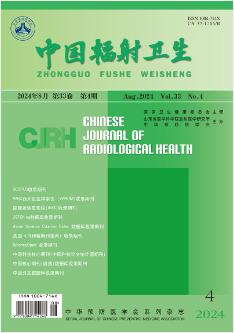TOMO-HD影像引导下不同体癌放疗设置误差的研究
引用次数: 0
摘要
目的研究基于巨压扇束CT的TOMO-HD影像引导对头颈部、胸部、腹部和盆腔肿瘤的设置误差,为TOMO-HD治疗计划系统提供从临床靶体积(CTV)到计划靶体积(PTV)的扩大边界。方法103例头颈部癌(30例)、胸椎癌(42例)、腹盆腔癌(31例)。在每次治疗前,采用基于超高电压扇束CT的图像引导技术获取CT扫描结果。从系统自动重构的断层图像中可获得患者的左右(X)、上下(Y)、前后(Z)和旋转(Fy)设置误差。计算三个维度的系统误差和随机误差,并检查设置的数据是否符合正态分布,然后获得三个方向上展开的数据。根据593扇形波束CT扫描结果,这种转变错误(µ±s)在X, Y, Z和财政年度(旋转)的三个研究小组(毫米(−0.31±2.16),(1.09±3.56)毫米,mm(2.36±2.27),(0.29±0.96)°)(头部和颈部肿瘤),[(−0.98±2.95)毫米,mm(0.45±6.86),(3.79±2.47)毫米,(0.18±0.60)°)(胸癌)和((−0.86±2.85)毫米,(−1.59±6.91)毫米,mm(5.77±2.40),(0.20±0.68)°)(腹部和骨盆癌)。头颈、胸腹、盆腔肿瘤患者X、Y、Z维度的系统误差(Σ)和随机误差(Σ)分别为(1.06 mm和1.84 mm)、(1.93 mm和3.43 mm)、(2.41 mm和2.71 mm)、(1.10 mm和2.56 mm)、(3.79 mm和5.46 mm)、(1.38 mm和1.99 mm)、(1.39 mm和0.87 mm)、(4.98 mm和5.69 mm)、(1.19 mm和2.05 mm)。结论建议作为参考图像指导TOMO-HD根据设置错误的频率分布,患者的头部和颈部,胸部和腹部和盆腔肿瘤,运动在三维空间的最大射程是mm(5.00, 5.00, 5.00),(63、17.25、16.00)毫米,(6.49,16.24,13.60)毫米。摘要:目的利用TOMO-HD螺旋加速器的MV级扇形束CT研宄头颈部,胸部、腹盆部肿瘤在放疗中的摆位误差,为PTV边界的外扩提供数据支持。方法采用TOMO-HD螺旋断层系统分别对30例头颈部,42例胸部和31例腹盆部肿瘤患者每次放疗前行MV级扇形束CT扫描,系统自动重建图像并与治疗计划CT图像进行配准,获得患者左右(X轴),头脚(Y轴),腹背(Z轴),沿Y轴方向的旋转(年度)方向的摆位误差。计算出X, Y, Z的方向的系统误差(Σ)和随机误差(σ)并对摆位误差进行正态性检验,计算出PTV的各方向外扩边界。结果共行593次扫描,头颈部,胸部、腹盆部患者在X轴、Y轴,Z轴,方财政年度向(沿Y轴方向的旋转)的摆位误差(µ±s)分别为[(−0.31±2.16)毫米(1.09±3.56)毫米,mm(2.36±2.27),(0.29±0.96)°],[(−0.98±2.95)毫米,(−0.45±6.86)毫米,mm(3.79±2.47),(0.18±0.60)°]和[(−0.86±2.85)毫米,(−1.59±6.91)毫米,mm(5.77±2.40),(0.20±0.68)°)。头颈部,胸部、腹盆部患者在X轴、Y轴、Z轴方向的系统误差(Σ)和随机误差(σ)分别为(1.06毫米和1.84毫米)(1.93毫米和3.43毫米)(2.41毫米和2.71毫米)(1.10毫米和2.56毫米)(3.79毫米和5.46毫米)(1.38毫米和1.99毫米)和(1.39毫米和0.87毫米)(4.98毫米和5.69毫米)(1.19毫米和2.05毫米)。结论根据不同部位的摆位误差频数分布,头颈部,胸部、腹盆部不同部位肿瘤患者的靶区在三维方向上最大运动范围参考值为(5.00,5.00,5.00)毫米,mm(6.63, 17.25, 16.00)和(6.49,16.24,13.60)毫米,推荐以此作为图像引导参考。本文章由计算机程序翻译,如有差异,请以英文原文为准。
Study on setup errors for different body carcinoma radiotherapy with image guidance in TOMO-HD
Objective The literature study the setup errors of head and neck, thoracic, abdominal and pelvic
tumors by megavoltage fan-beam CT based image guidance in TOMO-HD to provide the margin
enlarging from clinic target volume (CTV) to planning target volume (PTV) in treatment
planning system of TOMO-HD.
Methods 103 patients with head and neck (30 patients), thoracic (42 patients), abdominal
and pelvic (31 patients) carcinoma were enrolled. Megavoltage fan-beam CT based image
guidance in tomotherapy-HD was used to acquire CT scan before every treatment. The
left-right (X), superior-inferior (Y), anterior-posterior (Z) and rotation (Fy) setup
errors of patients can be obtained from the tomography image automatically restructured
by the system. Calculating the systematic error and the random error in the three
dimensions and check whether the setup data accord with the normal distribution or
not, then acquire the data expand in the three directions.
Results According to 2 593 fan-beam CT scans, the shift errors (µ ± s) in X, Y, Z and Fy
(rotation) of three study group were [(−0.31 ± 2.16) mm, (1.09 ± 3.56) mm, (2.36 ±
2.27) mm, (0.29 ± 0.96)°] (head and neck tumor), [(−0.98 ± 2.95) mm, (0.45 ± 6.86)
mm, (3.79 ± 2.47) mm, (0.18 ± 0.60)°] (thoracic cancer) and [(−0.86 ± 2.85) mm, (−1.59
± 6.91) mm, (5.77 ± 2.40) mm, (0.20 ± 0.68)°] (abdominal and pelvic carcinoma). The
systematic errors (Σ) and random errors (σ) in X, Y, Z dimensions of patients with
head and neck, thoracic, abdominal and pelvic tumors were (1.06 mm and 1.84 mm), (1.93
mm and 3.43 mm), (2.41 mm and 2.71 mm), (1.10 mm and 2.56 mm), (3.79 mm and 5.46 mm),
(1.38 mm and 1.99 mm) and (1.39 mm and 0.87 mm), (4.98 mm and 5.69 mm), (1.19 mm and
2.05 mm), respectively.
Conclusion It is recommended as a reference for image guidance in TOMO-HD according to the frequency
distribution of setup errors, for patients with head and neck, chest and abdominal
and pelvic tumors, the maximum range of motion in three dimensions are (5.00, 5.00,
5.00) mm, (6,63, 17.25, 16.00) mm and (6.49, 16.24, 13.60) mm.
摘要: 目的 利用 TOMO-HD 螺旋加速器的 MV 级扇形束 CT 研宄头颈部、胸部、腹盆部肿瘤在放疗中的摆位误差, 为 PTV 边界的外扩提供数据支持。
方法 采用 TOMO-HD 螺旋断层系统分别对 30 例头颈部、42 例胸部和 31 例腹盆 部肿瘤患者每次放疗前行 MV 级扇形束 CT 扫描, 系统自动重建图像并与治疗计划
CT 图像进行配准, 获得患者左右 (X 轴)、头脚 (Y 轴)、腹背 (Z 轴)、沿Y轴方向的旋转 (Fy) 方向的摆位误差。计算出X、Y、Z方向的系统误差(Σ)
和随 机误差(σ)并对摆位误差进行正态性检验, 计算出 PTV 的各方向外扩边界。
结果 共行 2 593 次扫描, 头颈部、胸部、腹盆部患者在 X 轴、Y 轴、Z轴、Fy 方向 (沿 Y 轴方向的旋转) 的摆位误差 (µ ± s) 分别为 [(−0.31
± 2.16)mm、(1.09 ± 3.56)mm、(2.36 ± 2.27)mm、(0.29 ± 0.96)°], [(−0.98 ± 2.95)mm、(−0.45
± 6.86)mm、(3.79 ± 2.47)mm、(0.18 ± 0.60)°] 和 [(−0.86 ± 2.85)mm、(−1.59 ± 6.91)mm、(5.77
± 2.40)mm、(0.20 ± 0.68)°]。头颈部、胸部、腹盆部患者在 X 轴、Y 轴、Z轴方向的系统误差(Σ)和随机误差(σ)分别为 (1.06 mm 和
1.84 mm)、(1.93 mm 和 3.43 mm)、(2.41 mm 和 2.71 mm)、(1.10 mm 和 2.56 mm)、(3.79 mm 和 5.46
mm)、(1.38 mm 和 1.99 mm) 和 (1.39 mm 和 0.87 mm)、(4.98 mm 和 5.69 mm)、(1.19 mm 和 2.05
mm)。
结论 根据不同部位的摆位误差频数分布, 头颈部、胸部、腹盆部不同 部位肿瘤患者的靶区在三维方向上最大运动范围参考值为 (5.00, 5.00, 5.00)mm, (6.63,
17.25, 16.00)mm 和 (6.49, 16.24,13.60)mm, 推荐以此作为图像引导参考。
求助全文
通过发布文献求助,成功后即可免费获取论文全文。
去求助
来源期刊
CiteScore
0.80
自引率
0.00%
发文量
7142
期刊介绍:
Chinese Journal of Radiological Health is one of the Source Journals for Chinese Scientific and Technical Papers and Citations and belongs to the series published by Chinese Preventive Medicine Association (CPMA). It is a national academic journal supervised by National Health Commission of the People’s Republic of China and co-sponsored by Institute of Radiation Medicine, Shandong Academy of Medical Sciences and CPMA, and is a professional academic journal publishing research findings and management experience in the field of radiological health, issued to the public in China and abroad. Under the guidance of the Communist Party of China and the national press and publication policies, the Journal actively publicizes the guidelines and policies of the Party and the state on health work, promotes the implementation of relevant laws, regulations and standards, and timely reports new achievements, new information, new methods and new products in the specialty, with the aim of organizing and promoting the academic communication of radiological health in China and improving the academic level of the specialty, and for the purpose of protecting the health of radiation workers and the public while promoting the extensive use of radioisotopes and radiation devices in the national economy. The main columns include Original Articles, Expert Comments, Experience Exchange, Standards and Guidelines, and Review Articles.

 求助内容:
求助内容: 应助结果提醒方式:
应助结果提醒方式:


